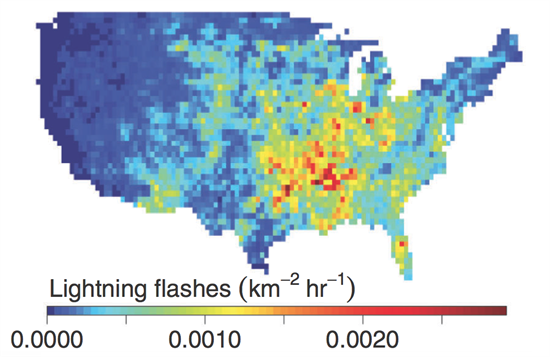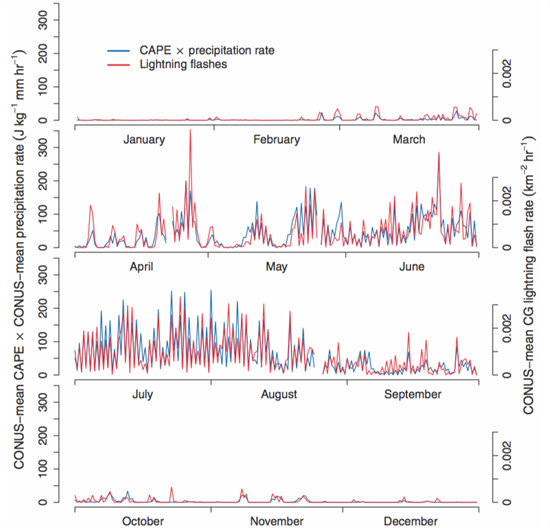Robert McSweeney
13.11.2014 | 7:25pmClimate change is likely to increase the number of lightning strikes, according to a study that models the effect of a warmer climate on lighting in the US.
Lightning already strikes the US about 25 million times each year, causing dozens of deaths and millions of dollars’ worth of damage from fires. The study finds the number of strikes could increase by around 50 per cent through the 21st century.
Static electricity
When static electricity builds up in large storm clouds it can discharge as lightning, either extending into the air, within the cloud itself, or striking the Earth’s surface. The electricity is generated as water droplets and ice crystals bump into each other as they rise and fall within the cloud.
There are around 25 million lightning strikes in the US every year, mostly on the eastern side of the country. The map below plots them.
US Map showing number of cloud-to-ground lightning strikes in the year 2011. Red and orange pixels show more strikes per square kilometer per hour than blue pixels. Romps et al. ( 2014)
New research, published in Science, suggests that lightning strikes in the US will increase by 12 per cent for every degree of temperature rise, if greenhouse gases continue to be emitted at current levels.
So if temperatures rise by two degrees, lightning strikes will increase by almost a quarter. Four degrees will mean an increase of around a half, meaning over 10 million more lightning strikes per year.
A warmer world
Lightning is more likely in a warmer world because thunderstorms need warm, rapidly-rising air in order to develop.
But working out how lightning will be affected by climate change is difficult because climate models don’t simulate lightning directly.
The study approximates lightning in climate models by combining the two factors of rainfall and the amount of energy in the atmosphere, which makes air rise.
The approximation matches closely to actual occurrence of lightning, the researchers say. The graph below shows the comparison between their approximation (blue line) and the lightning strikes (red line) for the year 2011. You can also see that the majority of lightning strikes hit during spring and summer.
Time series plot of actual lightning strikes (red line) and study approximation of lightning (blue line) in the US for the year 2011.
Once the researchers had a way of representing lightning in climate models, they can run them and see how lightning strikes change as temperatures rise.
Wildfires
Lightning strikes are the second leading cause of storm-related deaths in the US after flooding. 25 people have been killed so far this year.
Lightning also causes further damage by starting fires. In the average year, lightning causes over 30,000 fires in the US, causing nine deaths, 53 injuries, and $451 million in property damage. Around 9,000 of these are wildfires, each burning an average of over 400 acres of land.
Wildfires are expected to become more of a problem for the US as temperatures rise. For example, a report by the US Department of Agriculture finds that the area burned by wildfires will at least double by the middle of the 21st century.
So with warmer conditions likely to leave much of the US more susceptible to wildfires, it won’t come as good news that there might be over 10 million more potential triggers.
Romps, D.M. et al. (2014) Projected increase in lightning strikes in the Unites States due to global warming, Science, 10.1126/science.1259100



